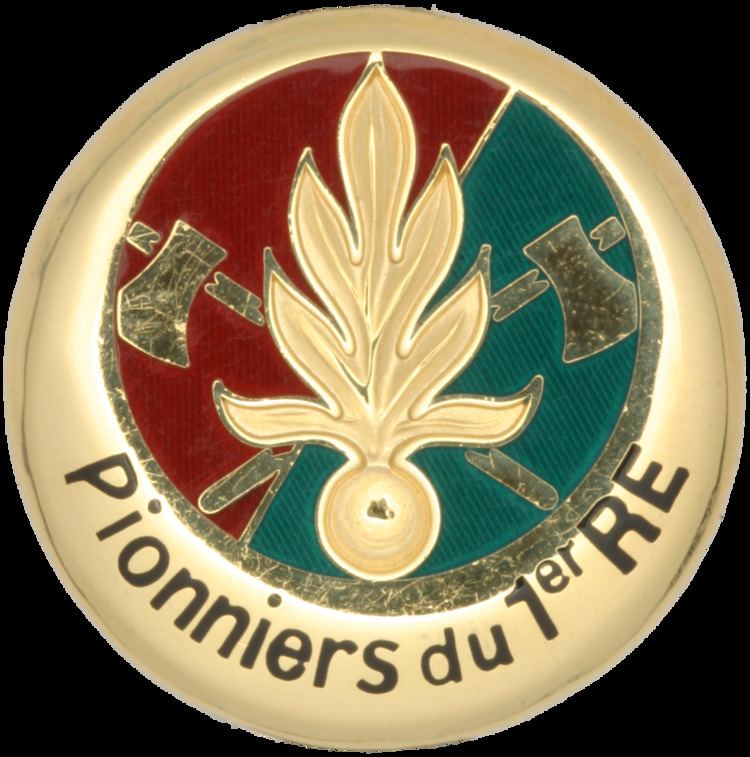Active 1831 - Present Nickname(s) Pionniers | Motto(s) Honneur et Fidélité | |
 | ||
The Pioneers of the French Foreign Legion (French: Pionniers de la Légion étrangère) form a unit of tradition. They lead and open legion parades during all honorific ceremonies of arms and wear beards, buffalo leather aprons (French: tablier de buffle), and arm resting axes on their shoulders.
Contents
- History of the Pionniers
- Pionniers of Tradition
- Function of Tradition
- Honoring the Legion Sous Officiers
- Uniform of Tradition
- Regimental Song
- Decorations
- Battle honours
- References
The unit is considered the only of its kind and type in service within the French Army and France.
History of the Pionniers
Early in the XVIII century; small pionnier units, the axemen soldiers in the Grenadier combat companies see action in the corps regiments serving the French Royal Army. Their mission then was to mount assaults at the head of all combat units in order to destroy the obstacles created by the enemy.
Following a rather aleatory presence under the French Revolution, the pionniers reappear under the French Consulate, wearing hairy grenadier caps without the metallic plate. These units were dissolved in 1818 and recreated in 1822.
The French Foreign Legion retook, since 1831, that tradition which is still an integral part till present days.
Unlike the Pionniers of the Foreign Legion; the remainder of Pioneer units in the French Army were dissolved under the French Third Republic.
Pionniers of Tradition
In 1920 and 1921, two sapper combat companies of pionniers were created at the corps of the four foreign legion regiments operating in Morocco. These units are tasked with engineering functions, mainly in terms of infrastructures (construction of roads, bridges, tunnels). These units did not carry any axes, however, they wore the insignia of tradition of the pionniers.
On April 30, 1931, during the 100th year celebration of the French Foreign Legion, orchestrated by general Paul-Frédéric Rollet, a section (platoon) of the sapper combat company of the 3rd Foreign Infantry Regiment paraded at the head of all parading troops while bearing the attributes of the pionniers, retaking the traditions of their predecessors.
Pionnier units were integrated officially within the ranks of tradition in 1946 by colonel Louis-Antoine Gaultier.
Function of Tradition
Certain regiments of the French Foreign Legion (1e R.E., 2e R.E.G, 3e R.E.I, 4e R.E., D.L.E.M) house even, punctually or permanently, groups of pionniers (in general, one Sous-Officiers and 9 Legionnaires); however, the section of tradition is part of the 1st Foreign Regiment of Aubagne and is composed of 3 Sous-Officiers and 36 Legionnaires.
This section (platoon) of pionniers of the 1st Foreign Regiment is the one that opens the way for the Legion heading the 14th of July military parade on the Champs-Élysées in Paris. The same section of pionniers is also employed during the commemoration ceremony of the Battle of Camarón, on April 30, at the 1st Foreign Regiment to frame protect the holder of the wooden hand of captain Jean Danjou.
Honoring the Legion Sous-Officiers
Military parades of the Foreign Legion are headed and opened by this section to maintain the tradition of sapeurs opening and clearing the way (French: ouvrant la route), always at the front, amongst worth and honor. Such is the custom of honoring the Legion Sous-officiers (Majors, Adjudant-chefs and Adjudants) since one of them always parades at the head of all French Foreign Legion regimental parades of France.
Uniform of Tradition
The Pionniers distinguish themselves by their specific and unique uniform :
Regimental Song
Chant de Marche : Nous sommes tous des volontaires featuring:
